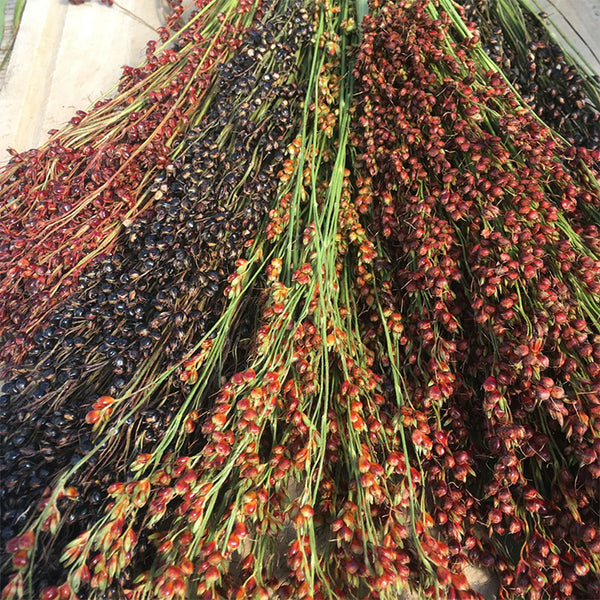Broomcorn (Sorghum), Amish Rainbow (Certified Organic Seeds)
$4.59
This item may be out of season or currently out of stock. Please check back.
Description: Tall ornamental that feeds the birds with its gorgeous tassels of red, orange and black seeds. Traditionally, this plant has been used to craft straw-like brooms. A gorgeous addition to the dried flower arrangements.
Certified Organic by Ecocert Canada/ Heirloom/ Open Pollinated/ Non-GMO
Pack Size: 60 seeds
Latin Name: Sorghum bicolor
Main Uses: Vegetable
Days to Maturity: 90 - 100 days
Exposure: Full sun
Certified Organic: Ecocert Canada
Germination: 71 days at 24ºC. Requires warm soil - so plant in early June for zone 3.
Starting indoors: Not suited to starting in pots indoors.
Outdoors: Direct-seed in early June, once the soil has warmed and there is no chance of frost. Seeds may rot if the soil temperature is too low.
Planting Depth: 1/2".
Spacing: Sow seeds 4” apart and thin to 12” apart when plants are 3” tall.
Planting out: Plant in well-drained fertile soil after all danger of frost has passed.
Growing in Containers: May be grown in larger planters, such as half barrels and raised beds, provided you direct seed to the growing location.
Fertilizing (Containers): Requires rich soil and regular application of a higher-nitrogen organic fertilizer, such as fish emulsion.
Watering (Containers): Requires regular, deep watering at the base of the stalks.
Growing in Mixed Planters: Not suited for mixed planters.
Fertilizing (Garden): Plant in a garden bed recently amended with quality compost. Feed weekly with a higher nitrogen organic fertilizer. Sorghum is a heavy feeder and requires rich, fertile soil and benefits from the addition of good quality compost such as Sea Soil. Rotate legumes with sorghum each year to help meet nutrient needs.
Watering (Garden): Water young plants regularly to establish, then water deeply as conditions require.
Garden Companions: Try planting lettuce in between rows of sorghum - the sorghum will provide the lettuce with some shelter from the heat and sun.
Pest/Disease Issues: To prevent rust, water early in the day and avoid getting water on the plants. Allow for sufficient air circulation by following the recommendations for plant spacing.
Harvesting: Harvest in fall once the seedheads have turned a golden-brown, plants have started drying down and the seeds are firm if squished between fingernails.
Suitability for Indoors: Not suited for indoors.







